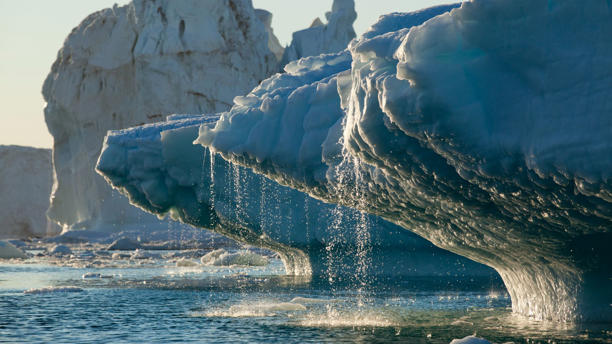
Why did the last ice age end?
Story by Cameron Duke
Nearly 10,000 years ago, Earth came out of its most recent ice age. Vast, icy swaths of land around the poles thawed, melting the glaciers that had covered them for nearly 100,000 years.
Why, after such a long period of cold, did the ice age finally come to an end? Scientists are still searching for the answer.
“One of the big questions in my research field right now is why the last ice age ended,” Brenda Hall, a glacial geologist and professor of Earth and climate sciences at the University of Maine, told Live Science.
Hall said that the traditional explanation — and short answer — for why ice ages begin and end is a series of eccentricities and wobbles in the planet’s orbit known as the Milankovitch cycles. Named after Serbian scientist Milutin Milankovitch, these cycles describe patterns in Earth’s orbit and axial tilt. Over time, our planet’s orbit around the sun alternates from being more circular to more egg-shaped. At the same time, our planet’s axis tends to both tilt and wobble.
Milankovitch found that these factors combine at regular intervals to cause land at 65 degrees north latitude (a parallel that runs through Canada, Alaska and parts of Eurasia) to become warmer than normal and theorized that this warming and then subsequent cooling of the Northern Hemisphere explained the planet’s cycle of ice ages — or glacials — and warmer periods — or interglacials.
“Quite simply, we can say that ice ages line up with these Milankovitch oscillations,” Hall said. “But we don’t know exactly why.”
However, while there is evidence that Milankovitch cycles drive the ebb and flow of ice ages, many modern glaciologists don’t think the cycles’ reported ties to ice ages completely checks out. One issue is that when the glaciers in the Northern Hemisphere melted, glaciers in the Southern Hemisphere melted too. But with the traditional explanation, it’s unclear how warming in one hemisphere would melt glaciers in the other — especially when, according to Hall, the Milankovich-driven changes in sunlight intensity that would produce warmer temperatures in the north would cause temperature drops in the south, counterbalancing any net warming.
In recent years, glaciologists have attempted to fill in the gaps between what we know about Milankovitch cycles and Earth’s ice ages. Hall said that the missing link needs to explain how these cycles cool and warm the entire planet at once, not just one hemisphere at a time.
“There has to be some way to get the whole globe to actually warm up at once,” Hall said.
One possible explanation is that when the Northern Hemisphere began to warm around 13,000 years ago, meltwater and icebergs flooded the North Atlantic Ocean, causing a temporary cooling of the Northern Hemisphere known as the Younger Dryas period (12,900 to 11,700 years ago). There is some evidence that the Younger Dryas affected ocean currents in a way that caused the Southern Atlantic to warm up, stirring up the ocean in the process and releasing tons of stored carbon dioxide into the atmosphere, which in turn caused glaciers in the Southern Hemisphere to melt over the next 1,500 years. The end result was likely a more carbon-rich atmosphere that continued to warm both hemispheres, lifting the planet out of the glacial period.
Another hypothesis, published in 2021, suggests that the length and intensity of the Southern Hemisphere’s winters could dictate when ice ages end. On the surface, it sounds like the polar opposite of the Milankovitch theory, which suggests that Northern Hemispheric summers drive the climatic changes. However, long winters in the Southern Hemisphere alter wind patterns near the tropics, which can create frequent storms over an area of the Pacific Ocean known as the Tropical Warm Pool — a region of ocean that stores and releases great amounts of heat. Altered winds can create storms in this area, which in turn releases massive amounts of water vapor that can act as a greenhouse gas.
Another idea is that salty water pouring from the Indian Ocean into the Atlantic Ocean helped end the last ice age. The Indian Ocean had become super salty because a drop in sea level had cut off a critical current that flows from the Pacific to the Indian Ocean; normally, this current diluted the Indian’s very salty tropical waters. A change in wind patterns and currents in the Indian Ocean could have caused the Indian Ocean to dump tons of dense, salty water into the Atlantic Ocean, altering its currents and temperatures in both the Northern and Southern hemispheres.
More evidence is needed to know for sure if any of these hypotheses can actually explain why the last ice age ended. But glaciologists are continuing to look into this cold case.

So scientists are admitting the Earth has cycles that cause glacial and interglacial periods and they don’t know the reasons for changes. There have been at least 7 of these cycles we can see evidence of. We are 10,000 years into the current warming after 100,000 years of the latest ice age. Therefore we have global warming.
They know the exact reason but it can’t be exploited for profit. The earth’s orbit moves closer to/further away from the sun when it passes near the orbits of the second and fourth planets. Since those orbits move at different but consistent speeds from our own the changes are entirely predictable and traceable through history.